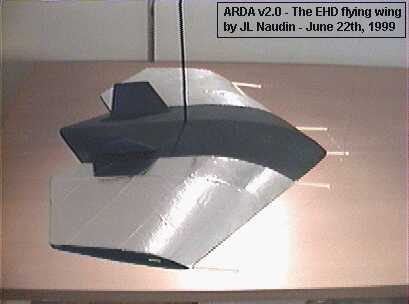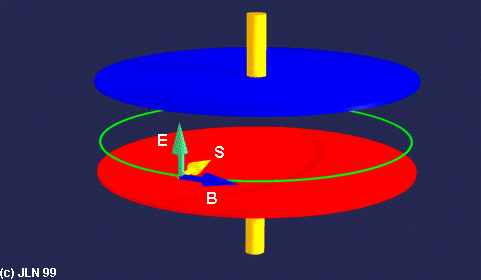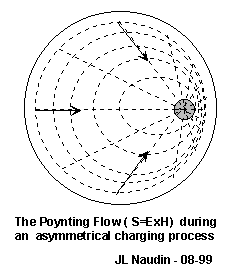
Thinkings on Electrogravitics
by Jean-Louis Naudin
Created on 05th June, 2000 - JLN Labs - Updated on March 16, 2004

Thinkings on Electrogravitics
by Jean-Louis Naudin
Created on 05th June, 2000 - JLN Labs - Updated on
March 16, 2004
Today, after some experiments and investigations about Electrogravitics and EHD, I think that the Biefeld-Brown thrust observed has four main causes :
1) A simple and common electric wind effect by Corona discharge : When a needle or a thin wire is connected to an electrostatic generator, a corona discharge take place from the sharp points. The air near these points become charged with charges of the same polarity as that of the device and is then repelled from the points due to the repulsion of like charges (the resulting motion of the air is known as the "electric wind"). Similarly, the points themselves are repelled from the charges in the air and the device move in the opposite sense to that in which the points are directed ( this is pure EAD (Electrokinetic), this is not the most interesting effect ).

2) An hydrostatic pressure differential effect between the upper and the inner the curved surface ( the Coanda/Bernoulli effect ), this is only a surface effect.
The hydrostatic pressure (which can be compared to aerodynamic pressure) is lower on the upper surface of the cupola than on the inner surface of the cupola. This can be compared to a conventional airplane wing with the extrados ( upper surface of the wing ) and the intrados ( lower surface of the wing ). This differential pressure is the direct cause of the EHD-FS lift.
( This works only in an atmospherical or a fluid environment, this is EHD (ElectroHydroDynamics), used with a plasma skin this is EPD (ElectroPlasmaDynamic))For more informations, see :
3) An inertial effect generated by an asymmetrical centrifugal force generated by the dielectric itself. This affect all the dielectric ( an atomic structure effect ) and this why a high-K dielectric is used. This may work in full vacuum environment ( deep space )....( an Electrogravitic effect )
<< This force, independent of the movement of ions or any mechanical reaction there from, operates in the direction of negative to positive as the voltage is increasing, and presumably in the opposite direction as the voltage is decreasing.
In vacuum (10-6 mm Hg or less), one interesting effect is observed : Any simple vacuum capacitor will appear to "flash" as the voltage increases, and, concurrent with the vacuum spark, an impulse force is noted in the direction of negative to positive. >> Thomas Townsend Brown (Leesburg,VA, April 7, 1956)The main problem in the most of case about the T.T. Brown experiments which use high voltage, is that the two first effects (1: EAD) and (2: EHD) hide this third Electrogravitics effect discovered by T.T.Brown in 1956 at 10-6 mm Hg.
Informations sources and references :
"The Gravitation Conception and Experiments" - by Alexander V. Frolov
"Reactionless Propulsion and Active Force" - by Alexander V.Frolov
"Experiments on the T.T.Brown effect conducted by T.Musha" from the book "Review of Some Field Propulsion Methods from the General Relativistic Standpoint" by Iwanaga Noriki
Electric Spacecraft Journal (ESJ) Issue 29 page 23, Jan/Feb/Mar 99
4) An energy flow effect generated inside the dielectric medium during the charge of an asymmetrical capacitor (an Electrogravitics effect) :
During a charging process of a flat capacitor, the Poynting vector ( S=ExH ) comes from outside the capacitor towards the wire connections, parallel to the surface of the armatures inside the dielectric medium. There is an energy flow directly proportional to ExB. This energy is not provided by the wires but comes from the surrounding space around the capacitor. (ref: "The Feynman Lectures on Physics : Electromagnetism vol2, Chap: 27-5, fig 27-3" by Addison-Wesley Publishing company. ) >>


During the charging process, in a flat ASYMMETRICAL capacitor with the wires connected near the edge of the armatures, the energy flow (S-Flow) is asymmetrical. (see the picture above). It is possible to generate an unidirectional thrust by using an unbalanced flow of energy induced by an asymmetrical Poynting flow during the charging process in a flat capacitor. The resulting thrust shows that this principle can be used as a thruster in the vaccum space.
For more informations, see :
TT.Brown Mode |
Effect |
Type |
Works in Vacuum |
1 |
Electric wind
"Franklin tourniquet" |
EAD / Electrokinetic |
NO |
2 |
Hydrostatic Pressure
differential |
EHD / EPD (ElectroPlasmaDynamic) |
NO |
3 |
Inertial effect induced |
Electrogravitic |
YES |
4 |
Asymmetrical energy flow |
Electrogravitic |
YES |
You may also visit the Thomas Townsend Brown dedicated web site.
Click here to read the full PDF documentOther interesting ref : The Possibility of Strong Coupling Between Electricity and Gravitation by Takaaki Musha- Infinite Energy Magazine Issue 53 ( Jan-Feb 2004 ) page 61-64
| AIAA-2002-1131 “OUTSIDE THE BOX” SPACE AND TERRESTRIAL TRANSPORTATION AND ENERGY TECHNOLOGIES FOR THE 21ST CENTURY by Theodore C. Loder. Published by the American Institute of Aeronautics and Astronautics and presented at the 40th AIAA Aerospace Sciences Meeting and Exhibit, Reno NV. Paper number AIAA-2002-1131. Abstract : << This paper reviews the development of antigravity research in the US and notes how research activity seemed to disappear by the mid 1950s. It then addresses recently reported scientific findings and witness testimonies - that show us that this research and technology is alive and well and very advanced. The revelations of findings in this area will alter dramatically our 20th century view of physics and technology and must be considered in planning for both energy and transportation needs in the 21st century.>> This paper can be downloaded at : http://users.erols.com/iri/Loder.PDF |
![]() Email : JNaudin509@aol.com
Email : JNaudin509@aol.com
Return to the Advanced propulsion page